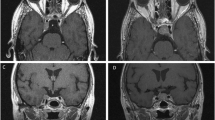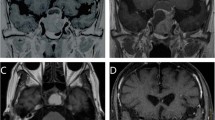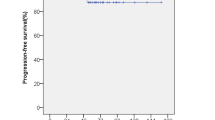Abstract
Objectives
Although the effectiveness of gamma knife radiosurgery (GKRS) in controlling the size of pituitary adenomas has been well demonstrated in many studies, the time period in which significant changes in tumor size occurs has been investigated in a limited fashion. It is important to determine the therapeutic window of GKRS in treating pituitary adenomas, i.e., the effective timeframe during which significant size reduction of these tumors occurs, so that alternative treatments such as further GKRS or microsurgery might be prescribed in a timely manner if clinically indicated.
Methods
This was a nested sample of an ongoing local cohort study on GKRS for pituitary adenomas at the University of Virginia. Magnetic resonance imaging (MRI) using dedicated sequences was employed. Only patients with a baseline MRI (TP0) and at least 1 follow-up study performed in the University Hospital after GKRS were included. The follow-up scans were performed at five time-points (TP1–TP5) which were 6, 12, 24, 36 and 48 months after GKRS. The dimensional indices of the tumors were measured in three orthogonal planes, i.e., transverse (TR), antero-posterior (AP) and cranio-caudal (CC). The volumes of the tumors were estimated by using the following formula: \({\text{V}} = \pi\,({\text{TR}} \times {\text{AP}} \times {\text{CC}})/6\). Tumor volume decrease by more than 25 % from baseline was considered as ‘shrinkage’, <25 % tumor size increase or decrease was considered ‘static’, and more than 25 % increase as ‘increment’. Our cohort consisted of 21 patients, with functioning adenomas in 13 subjects i.e. six adrenocorticotrophic hormone (ACTH)-secreting and seven growth hormone (GH)-secreting, and non-functioning (NF) adenomas in eight subjects.
Results
In 26 adenomas (8 ACTH, 9 GH and 9 NF), tumor control (tumor shrinkage or static) were achieved in 21 tumors (80.8 %); 89, 75, and 78 % for GH-secreting, ACTH-secreting and NF adenomas respectively, at the end of the 4-year follow-up period. Analysis of variance showed significant differences of GKRS margin dose among different types of tumors (p = 0.013), but not of baseline tumor volumes (p = 0.240). Logistic regression analysis showed no significant association of margin dose, baseline volume or tumor type with the tumor control outcome. Comparison of tumor change using dimensional indices relative to the base time point (TP0) showed that in the sample there was an average reduction of 1.290 mm at TP1 (6 months) with p values 0.155 (parametric t test) and 0.098 (non-parametric Wilcoxon signed-ranked test) respectively, showing a moderate reduction in tumor dimensional indices. The change in dimensional indices at later time points (TP2–TP5) showed an average reduction ranging from 1.930 to 2.471 mm. Significant reduction in the mean dimensional indices was firstly observed at TP2 (1 year) with p values 0.013 (t test) and 0.018 (Wilcoxon signed-rank test). Such scale of reduction in the dimensional indices appeared to be maintained along the time axis (from TP2 to TP5).
Conclusions
Significant decrease in tumor dimensional indices tended to occur at 1 year post-GKRS. Although to a lesser extent, such decrease in dimensional indices continued up to the end of our follow-up period.

Similar content being viewed by others

Abbreviations
- GKRS:
-
Gamma-knife radiosurgery
- NPA:
-
Non-functioning pituitary adenomas
- TR:
-
Transverse
- AP:
-
Antero-posterior
- CC:
-
Cranio-caudal
- TP:
-
Time point
- TP0:
-
Baseline
- TP1:
-
6 months
- TP2:
-
12 months
- TP3:
-
24 months
- TP4:
-
36 months
- TP5:
-
48 months
References
Laws ER Jr, Vance ML (1999) Radiosurgery for pituitary tumors and craniopharyngiomas. Neurosurg Clin N Am 10:327–336
Radhakrishnan K, Mokri B, Parisi JE, O’Fallon WM, Sunku J, Kurland LT (1995) The trends in incidence of primary brain tumors in the population of Rochester, Minnesota. Ann Neurol 37:67–73
Mortini P, Losa M, Barzaghi R, Boari N, Giovanelli M (2005) Results of transsphenoidal surgery in a large series of patients with pituitary adenoma. Neurosurgery 56:1222–1233; discussion 1233
Laws ER, Sheehan JP, Sheehan JM, Jagnathan J, Jane JA Jr, Oskouian R (2004) Stereotactic radiosurgery for pituitary adenomas: a review of the literature. J Neurooncol 69:257–272
Losa M, Valle M, Mortini P, Franzin A, da Passano CF, Cenzato M, Bianchi S, Picozzi P, Giovanelli M (2004) Gamma knife surgery for treatment of residual nonfunctioning pituitary adenomas after surgical debulking. J Neurosurg 100:438–444
Sheehan JP, Pouratian N, Steiner L, Laws ER, Vance ML (2011) Gamma knife surgery for pituitary adenomas: factors related to radiological and endocrine outcomes. J Neurosurg 114:303–309
Sheehan JP, Niranjan A, Sheehan JM, Jane JA Jr, Laws ER, Kondziolka D, Flickinger J, Landolt AM, Loeffler JS, Lunsford LD (2005) Stereotactic radiosurgery for pituitary adenomas: an intermediate review of its safety, efficacy, and role in the neurosurgical treatment armamentarium. J Neurosurg 102:678–691
Marko NF, LaSota E, Hamrahian AH, Weil RJ (2012) Comparative effectiveness review of treatment options for pituitary microadenomas in acromegaly. J Neurosurg 117:522–538
Barkan AL, Halasz I, Dornfeld KJ, Jaffe CA, Friberg RD, Chandler WF, Sandler HM (1997) Pituitary irradiation is ineffective in normalizing plasma insulin-like growth factor I in patients with acromegaly. J Clin Endocrinol Metab 82:3187–3191
Brada M, Ajithkumar TV, Minniti G (2004) Radiosurgery for pituitary adenomas. Clin Endocrinol (Oxf) 61:531–543
Prasad D (2006) Clinical results of conformal radiotherapy and radiosurgery for pituitary adenoma. Neurosurgery Clin N Am 17:129–141, vi
Rim CH, Yang DS, Park YJ, Yoon WS, Lee JA, Kim CY (2011) Radiotherapy for pituitary adenomas: long-term outcome and complications. Radiat Oncol J 29:156–163
Castinetti F, Nagai M, Morange I, Dufour H, Caron P, Chanson P, Cortet-Rudelli C, Kuhn JM, Conte-Devolx B, Regis J, Brue T (2009) Long-term results of stereotactic radiosurgery in secretory pituitary adenomas. J Clin Endocrinol Metab 94:3400–3407
Feigl GC, Bonelli CM, Berghold A, Mokry M (2002) Effects of gamma knife radiosurgery of pituitary adenomas on pituitary function. J Neurosurg 97:415–421
Franzin A, Spatola G, Losa M, Picozzi P, Mortini P (2012) Results of gamma knife radiosurgery in acromegaly. Int J Endocrinol 2012:342034
Kim M, Paeng S, Pyo S, Jeong Y, Lee S, Jung Y (2006) Gamma knife surgery for invasive pituitary macroadenoma. J Neurosurg 105(Suppl):26–30
Pollock BE, Cochran J, Natt N, Brown PD, Erickson D, Link MJ, Garces YI, Foote RL, Stafford SL, Schomberg PJ (2008) Gamma knife radiosurgery for patients with nonfunctioning pituitary adenomas: results from a 15-year experience. Int J Radiat Oncol Biol Phys 70:1325–1329
Sheehan JP, Jagannathan J, Pouratian N, Steiner L (2006) Stereotactic radiosurgery for pituitary adenomas: a review of the literature and our experience. Front Horm Res 34:185–205
Kobayashi T (2009) Long-term results of stereotactic gamma knife radiosurgery for pituitary adenomas. Specific strategies for different types of adenoma. Prog Neurol Surg 22:77–95
Kong DS, Lee JI, Lim DH, Kim KW, Shin HJ, Nam DH, Park K, Kim JH (2007) The efficacy of fractionated radiotherapy and stereotactic radiosurgery for pituitary adenomas: long-term results of 125 consecutive patients treated in a single institution. Cancer 110:854–860
Pollock BE, Brown PD, Nippoldt TB, Young WF Jr (2008) Pituitary tumor type affects the chance of biochemical remission after radiosurgery of hormone-secreting pituitary adenomas. Neurosurgery 62:1271–1276; discussion 1276–1278
Vik-Mo EO, Oksnes M, Pedersen PH, Wentzel-Larsen T, Rodahl E, Thorsen F, Schreiner T, Aanderud S, Lund-Johansen M (2007) Gamma knife stereotactic radiosurgery for acromegaly. Eur J Endocrinol 157:255–263
Attanasio R, Epaminonda P, Motti E, Giugni E, Ventrella L, Cozzi R, Farabola M, Loli P, Beck-Peccoz P, Arosio M (2003) Gamma-knife radiosurgery in acromegaly: a 4-year follow-up study. J Clin Endocrinol Metab 88:3105–3112
Jezkova J, Marek J, Hana V, Krsek M, Weiss V, Vladyka V, Lisak R, Vymazal J, Pecen L (2006) Gamma knife radiosurgery for acromegaly–long-term experience. Clin Endocrinol (Oxf) 64:588–595
Castro DG, Cecilio SA, Canteras MM (2010) Radiosurgery for pituitary adenomas: evaluation of its efficacy and safety. Radiat Oncol 5:109
Pamir MN, Kilic T, Belirgen M, Abacioglu U, Karabekiroglu N (2007) Pituitary adenomas treated with gamma knife radiosurgery: volumetric analysis of 100 cases with minimum 3 year follow-up. Neurosurgery 61:270–280; discussion 280
Starke RM, Williams BJ, Jane JA Jr, Sheehan JP (2012) Gamma knife surgery for patients with nonfunctioning pituitary macroadenomas: predictors of tumor control, neurological deficits, and hypopituitarism. J Neurosurg 117:129–135
Jagannathan J, Yen CP, Pouratian N, Laws ER, Sheehan JP (2009) Stereotactic radiosurgery for pituitary adenomas: a comprehensive review of indications, techniques and long-term results using the gamma knife. J Neurooncol 92:345–356
Wowra B, Stummer W (2002) Efficacy of gamma knife radiosurgery for nonfunctioning pituitary adenomas: a quantitative follow up with magnetic resonance imaging-based volumetric analysis. J Neurosurg 97:429–432
Mingione V, Yen CP, Vance ML, Steiner M, Sheehan J, Laws ER, Steiner L (2006) Gamma surgery in the treatment of nonsecretory pituitary macroadenoma. J Neurosurg 104:876–883
Sheehan JP, Kondziolka D, Flickinger J, Lunsford LD (2002) Radiosurgery for residual or recurrent nonfunctioning pituitary adenoma. J Neurosurg 97:408–414
Losa M, Gioia L, Picozzi P, Franzin A, Valle M, Giovanelli M, Mortini P (2008) The role of stereotactic radiotherapy in patients with growth hormone-secreting pituitary adenoma. J Clin Endocrinol Metab 93:2546–2552
Higham CE, Chung TT, Lawrence J, Drake WM, Trainer PJ (2009) Long-term experience of pegvisomant therapy as a treatment for acromegaly. Clin Endocrinol (Oxf) 71:86–91
Jagannathan J, Sheehan JP, Pouratian N, Laws ER Jr, Steiner L, Vance ML (2008) Gamma knife radiosurgery for acromegaly: outcomes after failed transsphenoidal surgery. Neurosurgery 62:1262–1269; discussion 1269–1270
Conflict of interest
The authors reported no conflict of interest concerning the materials or methods used in this study or the findings specified in this paper.
Ethical standard
We declared that the experiments comply with the current laws of our country.
Author information
Authors and Affiliations
Corresponding author
Rights and permissions
About this article
Cite this article
Mak, H.KF., Lai, SW., Qian, W. et al. Effective time window in reducing pituitary adenoma size by gamma knife radiosurgery. Pituitary 18, 509–517 (2015). https://doi.org/10.1007/s11102-014-0603-8
Published:
Issue Date:
DOI: https://doi.org/10.1007/s11102-014-0603-8



